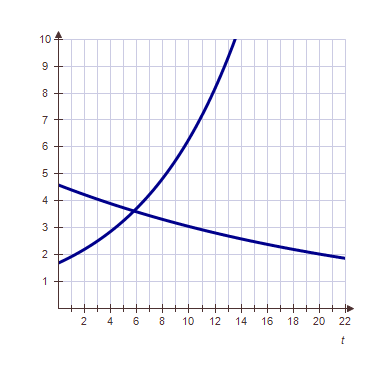On a certain island there are initially 4.6 new species per year introduced. This number decreases by 4% each year. But conditions cause some species to become extinct. Initially 1.7 species per year become extinct. The number increases by 14% each year.
?
A: Using N for new species per year, find a formula that gives the number of new species per year introduced after t years.
?
B: Using E for extinction rate, find a formula that gives the rate of extinction t years.
?
C: Make a graph that shows both N and E over the first 10 years.
?
D: When will the rate of extinction be the same as the rate new species are being introduced? Round your answer to two decimal places if necessary.
What will be an ideal response?

?
B:
?
C:
?
D: The rates are the same after 5.79 years.
?
You might also like to view...
Find the indicated sum of matrices. +
+ 
A.
[-2 -3 5]
B. 
C. 
D. 
Solve the inequality. Express your answer in set notation.x2 > 16
A. {x| -4 ? x ? 4} B. {x| x < -4 or x > 4} C. {x| x ? -4 or x ? 4} D. {x| x < -4 or x ? 4}
Solve the problem.The paired data below consist of the test scores of 6 randomly selected students and the number of hours they studied for the test. By using linear regression, the following function is obtained:  where x is number of hours studied and y is score on the test. Use this function to predict the score on the test of a student who studies 11 hours.
where x is number of hours studied and y is score on the test. Use this function to predict the score on the test of a student who studies 11 hours. 
A. 92.5 B. 83.8 C. 84.1 D. 74.1
Express the number in decimal form (without exponents).7.53 × 10-4
A. 0.0000753 B. -753,000 C. 0.00753 D. 0.000753

